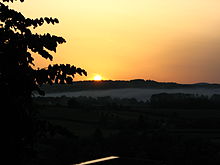Pecija's First Revolt
| Pecija's First Revolt | |||||||
|---|---|---|---|---|---|---|---|
 Sunset in Knešpolje, where the revolt took place |
|||||||
|
|||||||
| Belligerents | |||||||
| Local Serb peasants |
|
||||||
| Commanders and leaders | |||||||
| Strength | |||||||
|
|||||||
| Casualties and losses | |||||||
|
|||||||
Pecija's First Revolt (Serbian Cyrillic: прва Пецијина буна) or Doljani Revolt (Дољанска буна) was an uprising in Knešpolje led by Serb hayduk leader Petar Popović–Pecija (1826–1875) against the Ottoman government, that extended over the period of June—December 1858. It was a result of pressure against the local Serb populace, with past atrocities conducted by the Ottomans.
In 1857, an uprising was led by Luka Vukalović in Herzegovina, followed by the 1858 Uprising which included the Prota's Revolt in Gradačac srez (municipality), led by prota Avramović, and at the same time Pecija's Revolt in Krajina.
In mid-1858, an uprising broke out in northwestern Bosnia, resulting from Ottoman pressure against the local Serb populace. In Ivanjska in the Krupa nahiyah, the Serb population of that Catholic-majority village rose up. After short shootings around Ivanjska, the other villages took up arms. It is said that it originated in (tyranny) from the Ottomans. In June 1858, the uprising expanded on to Knešpolje. The leaders were former hajduk (bandit) Petar Popović–Pecija (1826–1875), Petar Garača (d. 1858), Simo Ćosić and Risto Jeić. The rural population of Knešpolje was predominantly consisting of Serbian Orthodox people, while the Muslim population predominantly lived in the cities. On June 20, the rebels pushed the Muslims into the city of Novi. Around 600 rebels summoned outside Novi, planning to attack the city. At the same time, Pecija and Garača had summoned around 3,000 rebels, which entered Ivanjska in order to help the local rebels. On July 4, in the battle of Doljani near Bihać, some 100 Turks fell, after which Jeić crossed into Austria, trying to convince the Austrians that these peasants with pitchforks and scythes were worth more than to live off bread. On July 15, the foothold at Ivanjska fell, where Pecija and Garača were. The rebel bands near Ivanjska were heavily defeated, with Pecija and Garača leading the survived rebels into Knešpolje, from where they gave their final resistance.
...
Wikipedia
